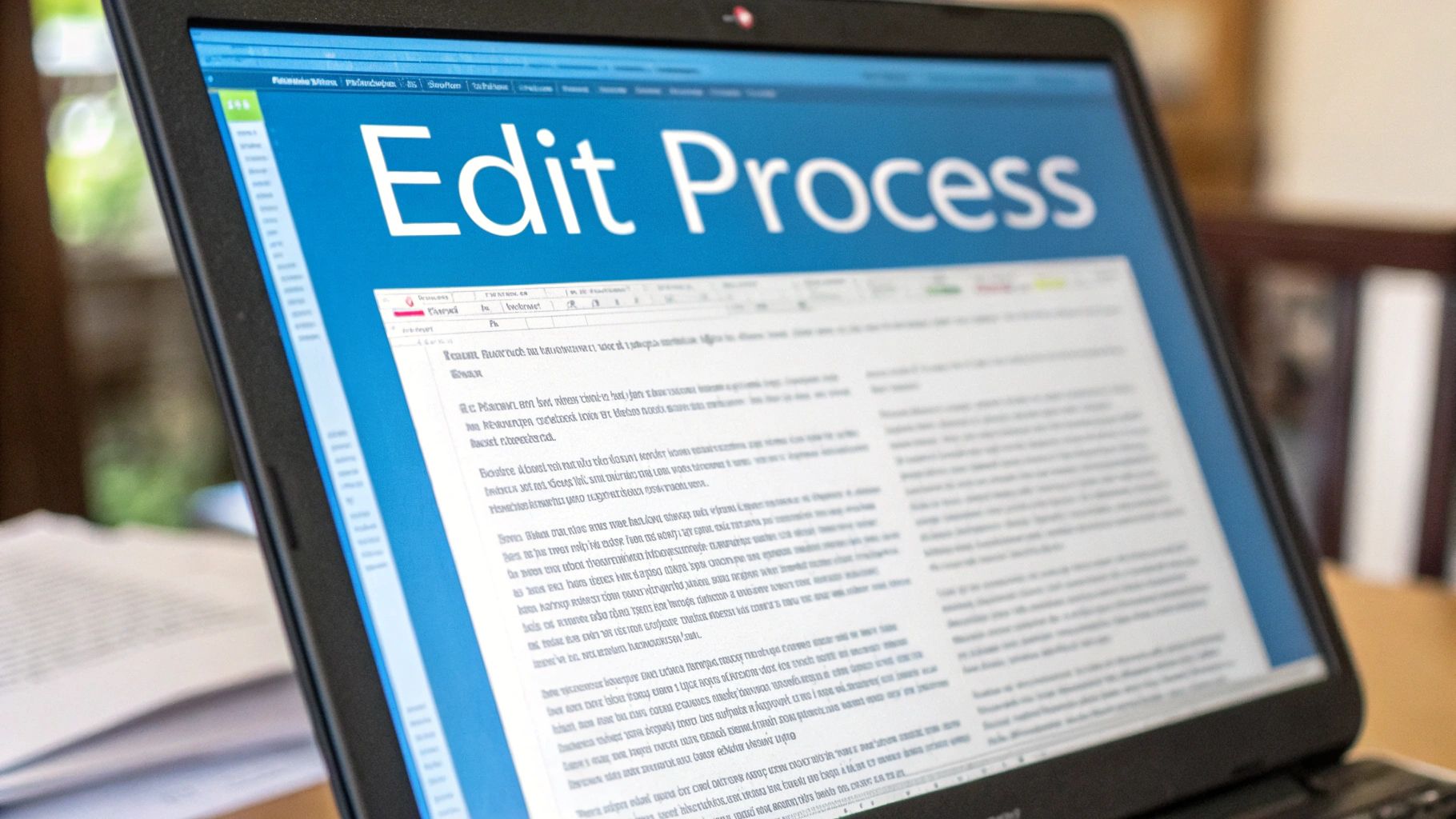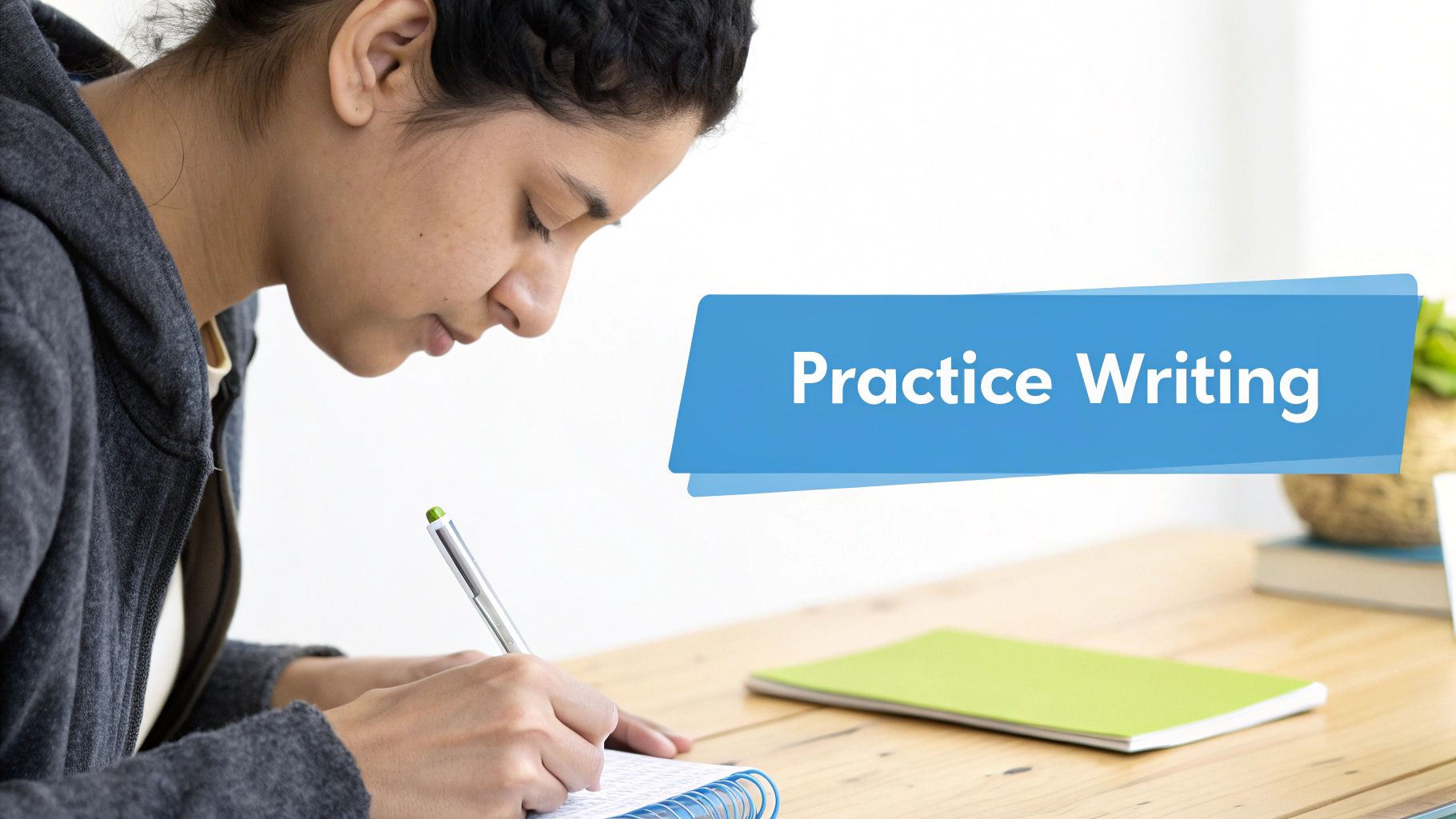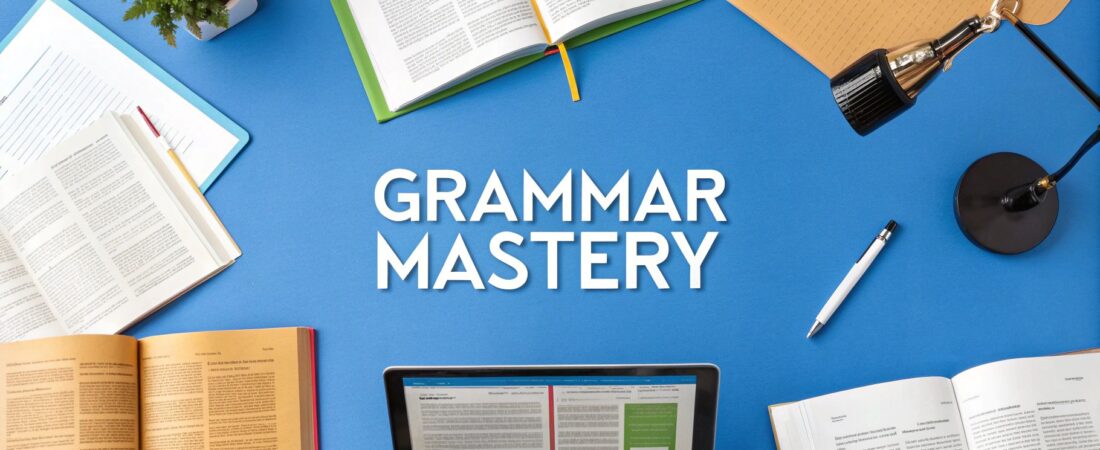Taking Control of Your Grammar Journey

Everyone makes grammar mistakes – it's a natural part of writing. Even experienced writers occasionally trip up on complex sentences or misplace punctuation. The key difference between good and great writers often comes down to their approach to catching and fixing these errors. This section explores practical ways to improve your grammar while building lasting confidence in your writing abilities. Remember, the goal isn't perfect grammar, but rather steady progress through consistent practice.
Identifying Your Grammar Blind Spots
The first step to better grammar is understanding your specific challenges. Think of it like developing any other skill – you need to know what to work on. For instance, you might notice that you frequently mix up "their" and "there" or struggle with comma placement in complex sentences. Start keeping a personal list of your common mistakes. This creates a customized reference guide you can use while editing and helps train your eye to catch these errors as you write. Over time, you'll find yourself naturally avoiding these pitfalls before they even make it to the page.
Developing a Systematic Approach
Fixing grammar goes beyond just running spell check – it requires a clear, step-by-step process. Start by reading your work out loud, which helps you catch awkward phrasing and missing words that your eyes might skip over. Next, use grammar checking tools to catch basic errors, but remember that these tools aren't perfect. They're helpful for spotting potential issues like passive voice or commonly confused words, but your own understanding of grammar rules should guide the final decisions. Consider creating a personal editing checklist based on your known trouble spots.
Making Time for Deliberate Practice
Like learning an instrument or mastering a sport, improving your grammar requires regular practice. This doesn't mean memorizing grammar rules for hours – instead, build small grammar checks into your regular writing routine. Set aside specific time for focused editing sessions where you look only at grammar issues. Go back to pieces you wrote months ago and try to spot errors you might have missed. Each editing session strengthens your grammar skills and builds your confidence as a writer. The key is consistency – even short but regular practice sessions will lead to noticeable improvements.
Embracing the Learning Process
Remember that mastering grammar is an ongoing journey. Every writer, even seasoned editors, makes occasional mistakes. The important thing is to learn from each error rather than getting discouraged. When you catch a mistake, take a moment to understand why it's wrong and how to fix it. This deeper understanding helps prevent similar errors in the future and gradually builds your grammar expertise. With time and practice, you'll find yourself writing with greater accuracy and confidence.
Understanding Modern Grammar Tools That Actually Work

Strong writing builds on two key foundations: solid grammar skills and effective tools to support them. While we've seen how methodical practice helps develop grammar mastery, modern grammar checking tools can be valuable allies in catching mistakes and refining your work. However, these tools work best when we understand both their capabilities and limitations. Much like a carpenter who knows when to use power tools versus hand tools, writers need to thoughtfully combine grammar tools with their own expertise.
Choosing the Right Tool for the Job
With numerous grammar checkers available, it's important to select one that matches your specific needs. Basic free tools like Grammarly excel at catching common errors in spelling, punctuation, and subject-verb agreement. For example, QuillBot stood out in testing by accurately identifying all 20 errors in a sample text. Premium tools go further by offering style suggestions, checking for plagiarism, and recommending clearer phrasing options. The right choice depends on your writing goals and budget constraints.
The Power of AI and Its Limitations
AI technology has greatly improved grammar checking capabilities. By analyzing massive amounts of text data, AI-powered tools can spot patterns and nuances that simpler rule-based systems miss. This allows for more accurate, context-aware suggestions. However, research shows that even advanced AI models can be overly cautious with certain types of errors, particularly those requiring deep contextual understanding. This highlights why human judgment remains essential – while these tools offer helpful guidance, writers should carefully evaluate each suggestion rather than accepting them blindly.
Integrating Tools Into Your Workflow
Success with grammar tools comes from using them strategically throughout your writing process. Rather than seeing them as replacements for your skills, treat them as helpful assistants that can catch what you might miss. Consider using basic checks during drafting to handle obvious errors, then applying more thorough tools during final editing to polish your work. This staged approach helps maintain writing flow while ensuring thorough proofreading. You might be interested in: How to master your grammar.
Beyond Automated Corrections: The Human Touch
While technology continues advancing, with the grammar checking market projected to reach $1,257.84 million by 2033, human expertise remains irreplaceable. Grammar tools excel at identifying technical errors but cannot fully grasp tone, style nuances, and intended meaning the way people do. The most effective approach combines AI-powered tools with strong grammatical knowledge and careful editing. This balanced method allows writers to produce polished, error-free content while maintaining their authentic voice and style.
Mastering Common Grammar Challenges

Even skilled writers struggle with grammar at times. While basic rules may seem straightforward, certain grammatical challenges require deeper understanding and practice. Learning to identify and fix these common issues will help you write more clearly and confidently.
Tackling Tricky Tense Agreements
Verb tense consistency often trips up writers, especially in longer sentences. For instance, accidentally switching between past and present tense can disorient readers and muddle your message. Think of tense like a timeline – each verb should align with when events actually occurred. When writing, pay attention to your starting tense and maintain it throughout unless there's a clear reason to switch.
Mastering Modifier Placement
Poor modifier placement can completely change a sentence's meaning or create unintended humor. A classic example is the dangling modifier, which lacks a clear subject to describe. Consider this sentence: "Running through the park, trees lined the path." This suggests the trees were running, not the person. A better version would be: "As I ran through the park, trees lined the path." Proper placement ensures your modifiers enhance rather than confuse.
Navigating Context-Dependent Errors
Some grammar rules shift based on how words function in a sentence. Take "who" versus "whom" – choosing correctly means understanding whether you need a subject or object pronoun. Similarly, "affect" and "effect" require examining whether you're describing an action or result. These nuanced distinctions often elude even automated grammar checks and demand careful analysis of meaning and sentence structure.
Honing Your Proofreading Skills
Strong proofreading habits help catch subtle errors that tools might miss. Reading work aloud reveals awkward phrasing and rough transitions. Some writers prefer marking up printed pages, while others edit best on screen. The key is finding methods that help you spot issues reliably. Try different approaches – like reading backward sentence by sentence or focusing on one type of error at a time – to discover what works for you.
Ensuring Consistency Across Longer Pieces
Maintaining consistent grammar becomes more challenging in longer documents. Just as character names shouldn't change mid-story, your grammatical choices should stay uniform throughout. This means tracking details like tense, voice, and style from start to finish. Creating style guides or checklists can help, especially for longer projects. When you maintain consistency, readers can focus on your ideas rather than getting distracted by shifting language patterns.
Building Your Grammar Correction Workflow
Good grammar doesn't require absolute perfection. Instead, it's about creating a reliable system that makes checking grammar a natural part of how you write. Think of it like a carpenter who keeps their tools sharp and organized – you need a clear process to maintain clean, clear writing.
Structuring Your Editing Process
A strong editing process works in stages, like refining a rough draft into a polished final piece. Start by getting your main ideas down without obsessing over every comma and period. During this first draft, do quick checks for obvious errors like typos or mismatched subjects and verbs, but keep your momentum going. This sets you up for more focused grammar work in later drafts.
Incorporating Tools Strategically
After completing your draft, it's time to bring in grammar checking tools to help catch issues. Programs like Grammarly and QuillBot excel at spotting problems like excessive passive voice or mixed-up words. However, remember that even the best tools have limitations. While QuillBot recently demonstrated its accuracy by identifying all 20 errors in a test passage, you still need human judgment to catch subtle issues. Consider each suggested change carefully rather than accepting them automatically.
The Power of Targeted Proofreading
While technology helps catch errors, developing your own proofreading skills leads to lasting improvement. Practice listening for grammar issues by reading your work out loud – this forces you to slow down and really hear how sentences flow. Going back to review older writing can also reveal patterns in your common mistakes. Regular practice helps train your ear to catch errors naturally.
Maintaining Consistency in Larger Projects
When working on longer pieces, keeping grammar consistent becomes especially important. Just as a story needs a consistent tone to engage readers, your grammar choices need to stay uniform throughout. Create a simple style guide for each project noting your decisions about things like verb tense and formatting. This helps prevent distracting shifts that could pull readers out of your content. With a clear system in place, you'll feel confident producing clean, error-free writing that keeps readers focused on your message.
Advanced Techniques for Professional-Level Writing

Now that you've mastered the grammar basics, let's explore techniques that take your writing to a professional level. These methods go beyond just correcting errors – they help you create clear, polished prose that engages readers and conveys your message effectively.
Mastering Parallelism and Balance
Good writers use parallel structure to give their writing rhythm and flow. This means using the same grammatical form when presenting similar ideas. For instance, instead of "She enjoys swimming, hiking, and to ride a bike," write "She enjoys swimming, hiking, and biking." Using parallel structure makes your writing more engaging and helps readers follow complex ideas more easily. When you maintain consistency in how you present related concepts, your writing becomes more cohesive and professional.
Eliminating Redundancy and Wordiness
Clear writing is direct writing. Extra words and redundant phrases only dilute your message. For example, replace "absolutely essential" with just "essential," or "due to the fact that" with "because." Learn more in our article about How to master your paraphrasing. When you trim unnecessary words, each remaining word carries more impact, making your writing more powerful and precise.
Strategic Use of Active and Passive Voice
While active voice usually makes writing clearer and more direct, passive voice serves specific purposes. Use active voice when you want to emphasize who performed an action: "John threw the ball." Choose passive voice when the actor is unknown or unimportant: "The ball was thrown." The key is knowing when each voice best serves your purpose. Active voice adds energy and clarity, while passive voice can be useful for emphasizing the action itself or maintaining an objective tone.
Developing a Keen Eye for Subtle Errors
Even with advanced grammar tools, some errors still slip through. Develop your editing skills by reading your work backward, sentence by sentence. This technique breaks the normal flow of reading and helps you spot typos, agreement issues, and awkward phrasing. Another effective approach is to focus on one type of error at a time – check punctuation in one pass, then subject-verb agreement in another. Professional editors use these methods to catch subtle mistakes that automated tools might miss.
Embracing Consistent Style and Tone
A consistent writing style creates a smooth reading experience. Think of your writing like music – each part should work together to create a unified whole. This means maintaining the same voice and style throughout your piece, especially in longer documents. Create and follow a style guide for punctuation, capitalization, and formatting choices. When readers don't get distracted by shifting styles or tones, they can focus entirely on your message. This attention to consistency marks the difference between good writing and excellent writing.
Creating Your Personal Grammar Strategy
Think of grammar improvement like training for a marathon – it requires a well-planned approach customized to your needs. Rather than trying to learn every grammar rule at once, the key is developing practices you can actually maintain long-term. With the right strategy, you'll catch mistakes more easily and write with greater confidence.
Building Your Personalized Checklist
Just as doctors have checklists for surgery, you need a checklist of your common grammar challenges. Look back at your recent writing – what errors keep popping up? Perhaps you mix up "their" and "they're" or struggle with punctuating complex sentences. Add these specific issues to your checklist. For example, if you often make subject-verb agreement mistakes, include a reminder to check for agreement during each editing pass. Having this focused list helps you target improvement where you need it most.
Establishing an Effective Review Process
A solid review process is essential for catching grammar mistakes before they reach your readers. Start by getting your ideas down without obsessing over grammar. Then step back and do a targeted review using your checklist. Reading your work out loud is especially helpful – your ears will catch awkward phrases and errors your eyes might miss. Breaking the review into clear stages makes it more manageable and effective.
Tracking Your Progress and Celebrating Wins
Seeing your grammar skills improve provides motivation to keep going. Consider keeping simple notes on the errors you catch and fix. This creates a record of your learning and shows you where you're making real progress. Be sure to acknowledge your improvements, even small ones. Maybe you finally mastered those tricky semicolons or went a whole document without mixing up "affect" and "effect." These victories, though modest, show you're growing as a writer.
Integrating Feedback and Continuous Learning
Think of feedback as valuable data rather than criticism. When someone points out a grammar mistake, take time to understand the underlying rule so you can apply it correctly going forward. For instance, if colleagues often note your overuse of passive voice, study active voice construction and practice incorporating it naturally. This positive approach to feedback accelerates your grammar growth. Check out our guide on How to master your grammar and get better results.
SmartStudi offers AI-powered tools to support your grammar journey, including advanced checking and paraphrasing capabilities. Visit us today to see how our tools can help strengthen your writing.
